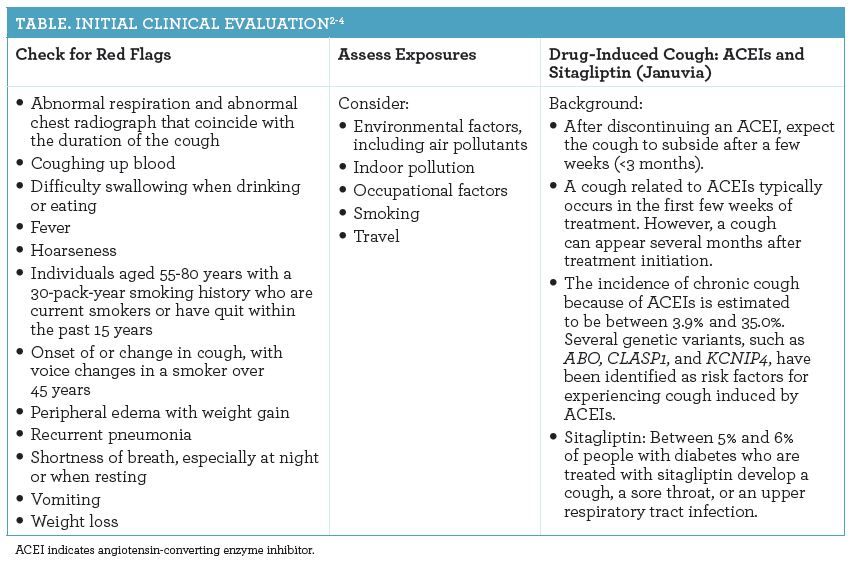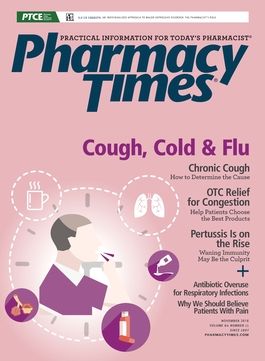Publication
Article
Pharmacy Times
Chronic Cough: Differential Diagnoses
Author(s):
A cough is the most common reason people seek medical attention in the United States.
A cough is the most common reason people seek medical attention in the United States.1 A recent study estimated that chronic cough affects 11% of the US population.2
A critical step first step in narrowing the list of potential diagnoses is to estimate a cough’s duration. An acute cough is defined as lasting <3 weeks, a subacute cough is defined as lasting between 3 and 8 weeks, while a chronic cough is defined as continuing >8 weeks.3
There are multiple causes of chronic cough, including asthma, gastroesophageal reflux disease (GERD), nonasthmatic eosinophilic bronchitis (NAEB), and upper airway cough syndrome, otherwise known as postnasal drip syndrome.1,2
When a patient presents with a chronic cough, an asthma assessment is recommended. A chronic cough is typically accompanied by difficulty with breathing or wheezing. However, in some cases, a cough may be the only symptom.2
Some global guidelines recommend the initiation of proton pump inhibitors (PPIs), along with diet and lifestyle modifications, with a diagnosis of chronic cough related to GERD. This class of recommendation stands if there are no warning signs and is recommended for only a limited time. This is because between 30% and 50% of patients with a chronic cough related to GERD do not respond to PPIs. And if the cough does not improve, the PPI should be discontinued.2
NAEB is characterized by eosinophilic inflammation, lacks a variable airflow obstruction and airway hyperresponsiveness, and responds to inhaled corticosteroids.2 In addition, a cough can be caused by several different upper respiratory conditions, such as allergic and nonallergic rhinitis, as well as chronic rhinosinusitis.2
The management of chronic cough is a diagnostic challenge and can also be frustrating for patients.2 Results of a survey of 1120 people in Europe who had a cough showed that a diagnosis was given in just 53% of cases. In addition, the results showed that the prescribed medications were judged as having limited efficacy 57% of the time, while the treatments were judged as not effective 36% of the time.2
When managing a chronic cough, it is critical to perform an initial clinical assessment that consists of evaluating environmental exposure, looking for warning signs such as an abnormal chest radiograph, and reviewing the medication profile and determining whether there are any medications known to cause a cough, including angiotensin-converting enzyme inhibitors and sitagliptin (Januvia).2,3 For additional details on first steps, see the Table.2-4

Other Causes to Consider
If the typical reasons are determined not to be the cause of a chronic cough, other diagnoses should be considered and further investigated. These include bronchiectasis and mycobacterial infection, bronchiolitis, interstitial lung disease, lung cancer, nonasthmatic pulmonary diseases such as chronic obstructive pulmonary disease, and obstructive sleep apnea.2
When assessing a chronic cough, it is important to consider tuberculosis in endemic areas and high-risk populations, even if chest radiographs are normal. Furthermore, it is important to note that treatment of GERD should not be limited to acid suppression. In terms of monitoring, routinely assess the cough severity and quality of life through validated tools before and after treatment. Furthermore, routinely follow up with patients 4 to 6 weeks after the initial visit.3
Other important treatment recommendations include3:
- Checking for compliance during follow-ups and assessing for barriers
- Checking for red flags (Table)
- Considering a referral to a cough clinic for refractory cough
- Continuing all partially effective treatments because of the possibility of multiple causes
- Optimizing therapy
- Routinely assessing for all exposures (Table)
For an algorithm detailing the assessment and management of a chronic cough published by American College of Chest Physicians, see the Figure.

A refractory chronic cough is a chronic cough that persists despite assessment and treatment.2 Treatments for refractory chronic cough were identified and reviewed in Treatment of Unexplained Chronic Cough: CHEST Guideline and Expert Panel Report by Gibson et al. In this 2016 publication, the treatments evaluated included nonpharmacologic approaches such as speech pathology therapy-based intervention, inhaled corticosteroids to target eosinophilic airway inflammation, neuromodulatory treatments (amitriptyline, gabapentin, and morphine), as well as other treatments including esomeprazole, ipratropium, and macrolides (erythromycin).2,5
New drugs are being developed based on newer concepts and comprehension of the mechanisms involved in refractory chronic cough and require further evaluation and study.2
Anyssa Garza, PharmD, BCMAS, is the vice president of content and patient education programs at Digital Pharmacist and an adjunct assistant professor at The University of Texas at Austin College of Pharmacy.
References
- McCrory DC, Coeytaux RR, Yancy WS Jr. Assessment and management of chronic cough [internet]. Rockville (MD): Agency for Healthcare Research and Quality (US). Agency for Healthcare Research and Quality (US); 2013;Jan. Report No.: 13-EHC032-EF.
- Perotin JM, Launois C, Dewolf M, et al. Managing patients with chronic cough: challenges and solutions. Ther Clin Risk Manag. 2018:14:1041-1051. doi: 10.2147/TCRM.S136036.
- Irwin RS, French CL, Chang AB, Altman KW; CHEST Expert Cough Panel. Classification of cough as a symptom in adults and management algorithms: CHEST guideline and expert panel report. Chest. 2018;153(1):196-209. doi: 10.1016/j.chest.2017.10.016.
- Baraniuk JN, Jamieson MJ. Rhinorrhea, cough and fatigue in patients taking sitagliptin. Allergy Asthma Clin Immunol. 2010;6(1):8. doi: 10.1186/1710-1492-6-8.
- Gibson P, Wang G, McGarvey L, Vertigan AE, Altman KW, Birring SS; CHEST Expert Cough Panel. Treatment of unexplained chronic cough. CHEST guideline and expert panel report. Chest. 2016;149(1):27-44. doi: 10.1378/chest.15-1496.







